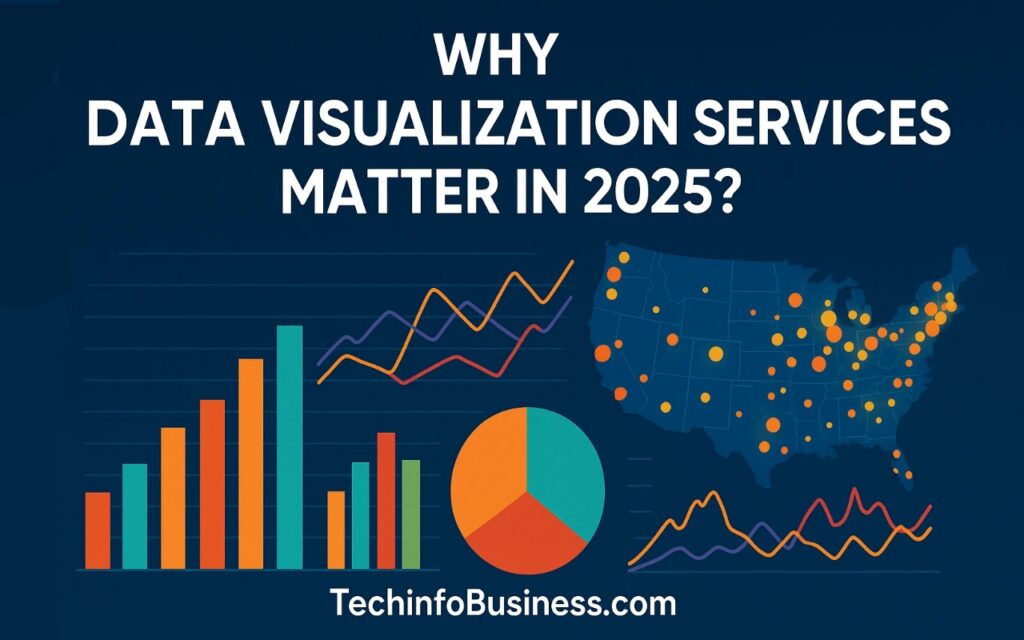Introduction
Data today is growing exponentially, and the ability to interpret and communicate insights effectively from this data has never been more critical. In 2025, data visualization is evolving beyond static charts into immersive, interactive, and AI-enhanced experiences.
With organizations relying on vast, complex datasets to drive decisions, visualization has become the key to turning raw numbers into actionable intelligence. From real-time dashboards to predictive storytelling, modern data visualization services empower businesses with unified data management, identifying trends, monitoring performance, and making informed strategic choices.
Emerging trends, personalization, automation, and accessibility are driving the next wave of visual analytics. Investing in data visualization services today means gaining a competitive edge tomorrow by making data not just readable, but truly understandable for everyone across the organization.
In this article, we explore the importance of data visualization, emerging trends, and top tools that one can leverage for efficient data visualization in 2025.
What is Data Visualization?
“Data visualization is the graphical representation of information and data using visual elements like charts, graphs, and maps. It transforms raw data into a visual context, making complex patterns and relationships easier to understand and interpret.”
The primary purpose of data visualization is to help users comprehend large volumes of information quickly. By presenting data visually, it simplifies the analysis process, supports pattern recognition, and facilitates effective communication across teams and stakeholders.
Why is Data Visualization Important?
In today’s data-driven environment, organizations collect massive amounts of information daily. However, raw data alone offers limited value. Data visualization bridges this gap by turning complex datasets into clear visuals, making data interpretation faster, more accessible, and actionable.
Here’s why data visualization is crucial for any business in 2025.
Enables Informed and Timely Decisions
Data visualization allows decision-makers to view trends and patterns at a glance, speeding up the decision-making process. With real-time visual dashboards, leaders can respond quickly to business needs, reducing risks and optimizing operational strategies based on data-driven insights.
Improves Communication and Stakeholder Buy-In
Visual data simplifies complex information. It offers ease in presenting insights to both technical and non-technical audiences. Engaging visuals improve clarity, foster better collaboration, and help stakeholders align on goals and outcomes more efficiently.
Spotting Patterns, Anomalies, and Opportunities
Visualization helps identify outliers, trends, and correlations within data sets that might be missed in raw form. This insight allows organizations to act proactively and seize growth opportunities or mitigate potential issues early on.
7 Emerging Data Visualization Trends You Must Know in 2025
Let’s explore the top new trends in data visualization that support effective decision-making.
1. AI-Powered Data Storytelling
AI is transforming data storytelling by automating insights and generating narratives tailored to business goals. These tools analyze complex data patterns, generate contextually relevant explanations, and help stakeholders understand key takeaways faster, enabling quicker and more strategic decision-making across all levels of an organization.
2. Real-Time Dashboards
Real-time dashboards provide live updates on business performance, empowering teams to respond instantly to changes. Whether tracking customer behavior or supply chain metrics, these dashboards foster agility, improve operational oversight, and allow organizations to make data-backed decisions when timing is critical.
3. Augmented & Immersive Analytics
Technologies like AR and VR are reshaping how users experience data by making it interactive and spatial. These immersive environments improve comprehension of complex datasets, offer deeper engagement, and support exploratory analysis, enabling more intuitive, informed decisions in high-stakes business contexts.
4. Mobile-Optimized Visualizations
As decision-makers increasingly rely on mobile devices, mobile-optimized visualizations ensure accessibility anytime, anywhere. These responsive designs adapt seamlessly across screen sizes, maintaining clarity and functionality, which allows executives and teams to analyze data and act on insights while on the move.
5. Predictive & Prescriptive Visualization
Moving beyond past and present data, predictive and prescriptive visualizations forecast trends and recommend actions. These tools integrate machine learning and historical data to guide strategic planning, identify risks, and suggest optimal solutions, making data not just informative but decisively actionable.
6. Personalized Data Experiences
Customized dashboards and views based on user roles, preferences, or objectives enhance relevance and engagement. By delivering only the most pertinent information, personalized visualizations reduce cognitive load and help stakeholders focus on metrics that directly impact their responsibilities and goals.
7. Data Democratization through Visualization
Simplified and intuitive visual tools are empowering non-technical users to explore and analyze data independently. This democratization fosters a data-literate workforce, enabling informed decision-making across departments and reducing reliance on data specialists for everyday analysis.
Top 10 Data Visualization Tools of 2025
Data visualization tools help transform large, complex datasets into clear and actionable visuals. While many tools offer similar capabilities, some stand out due to their flexibility, ease of use, or advanced functionality.
Here’s a list of the top 10 tools in 2025, along with their key strengths and limitations.
1. Tableau
Tableau offers a range of options, from desktop software to online-hosted versions and a free public platform. It supports various data sources, including CSVs, Google Analytics, and Salesforce. With robust mapping and charting features, Tableau makes data interpretation more intuitive.
Pros:
- Multiple data import options
- Strong mapping features
- Free public version
- Abundant tutorials
Cons:
- Paid versions are expensive
- Public version lacks data privacy
2. Dundas BI
Dundas BI is a flexible enterprise-grade tool supporting web-based dashboards and advanced analytics. Its drag-and-drop interface and HTML5 compatibility make it ideal for scalable, embedded deployments.
Pros:
- Customizable, embeddable dashboards
- Real-time data integration
- Scalable for enterprises
Cons:
- Steep learning curve
- Requires renting a dedicated server
- Costly for SMBs
3. Power BI
Microsoft Power BI delivers cloud-based analytics and rich visualizations. It integrates well with Microsoft tools and supports AI features, making it easy for teams to generate real-time insights.
Pros:
- Microsoft ecosystem integration
- Real-time dashboard updates
- Easy to use
Cons:
- Limited customization
- Complex pricing
- Slower with large datasets
4. Zoho Reports
Zoho Reports is a cloud-based solution ideal for smaller businesses. It offers drag-and-drop reporting, automated updates, and seamless integration with Zoho and third-party apps.
Pros:
- Budget-friendly
- Easy interface
- Good integration
Cons:
- Limited advanced features
- Slower data refresh in the free tier
5. Visual.ly
Visual.ly is a design-centric platform focused on infographics and data storytelling. Ideal for marketers, it emphasizes creativity and visual appeal over analytics depth.
Pros:
- Great for storytelling
- Customizable visuals
- Professional design support
Cons:
- No real-time analytics
- Limited interactivity
- High cost for custom work
6. Google Charts
Google Charts is a free, web-based tool for creating interactive, embeddable visualizations. It supports many chart types and runs on HTML5/SVG for full browser compatibility.
Pros:
- Free and open-source
- Cross-browser compatibility
- Supports dynamic data
Cons:
- Limited support resources
7. RAWGraphs
RAWGraphs is an open-source web tool designed for complex and unconventional visualizations. It’s ideal for designers looking to export visuals as vector graphics for refinement.
Pros:
- Free and web-based
- SVG export support
- Unique chart options
Cons:
- No real-time data support
- Limited integrations
8. IBM Watson Analytics
IBM Watson combines AI with visualization to provide enterprise-grade insights. It excels in predictive analytics and natural language processing for data queries.
Pros:
- AI-powered insights
- Natural language queries
- Scalable and secure
Cons:
- Expensive
- Complex interface
- Limited visual customization
9. Sisense
Sisense is a powerful tool known for embedding analytics and processing large datasets efficiently with its in-chip technology. It’s suitable for both developers and business users.
Pros:
- Fast performance
- Strong embedded analytics
- Highly customizable
Cons:
- High cost
- Requires tech skills
- Complex for beginners
10. Plotly
Plotly is an open-source tool known for producing interactive, high-quality graphs. It supports Python, R, and JavaScript, making it ideal for technical users and data scientists.
Pros:
- Open-source and flexible
- Supports multiple languages
- High-quality visuals
Cons:
- Requires coding knowledge
- Few pre-built templates
- Not beginner-friendly
Read More: vRealize Infrastructure Navigator: A Complete Solution for VMware Environments
Conclusion
In 2025, data visualization is no longer a nice-to-have; it’s a strategic necessity. With the exponential growth of data and the increasing demand for real-time, interactive insights, businesses must move beyond static charts to more dynamic, AI-enhanced, and mobile-optimized visualizations.
Whether it’s making timely decisions, enhancing stakeholder communication, or uncovering hidden trends, modern data visualization is the key to unlocking business value.
From tools like Tableau and Power BI to platforms like RAWGraphs and Visual.ly, organizations have a wide array of solutions to choose from, each catering to different needs and expertise levels.
To stay competitive and data-driven, businesses must invest in the right data visualization services tailored to their goals.
Partner with a trusted data visualization company to implement robust, scalable, and intuitive data visualization solutions that turn complex datasets into impactful decisions.



